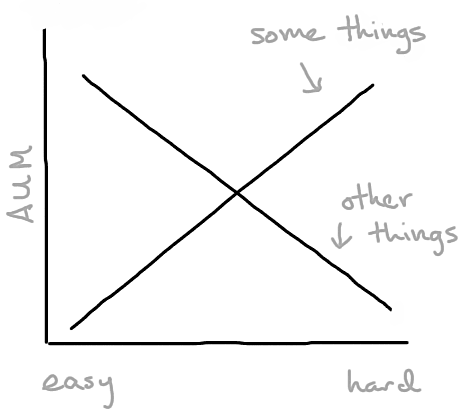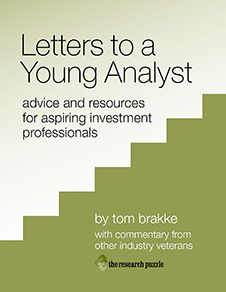
- Wednesday, November 3rd, 2010
- size matters
-
When asked about the differences in investing between individual investors and those that manage other people’s money, I often say, “It’s just zeros.” To a great extent, investment decisions are made on percentage allocations in each case, with simple math determining whether holdings are in hundreds or thousands or millions or billions. Arriving at the ideas and the position weights are much the same. However, the size of the assets under management does come into play at times:
 With all kinds of investments now available to the masses that weren’t before, it’s tempting for individuals and small managers to try to adopt strategies that in years past wouldn’t have been available to them. Foreign exchange trading is ubiquitous, and sometimes the first thing a neophyte investor learns these days is the proper usage of “pips.” Commodities and other assets that were hard to invest in before are now easy to come by, and derivative strategies and hedge fund clones put all sorts of tools on the table. Each must be examined carefully, for there may be hidden surprises in the packaging.
With all kinds of investments now available to the masses that weren’t before, it’s tempting for individuals and small managers to try to adopt strategies that in years past wouldn’t have been available to them. Foreign exchange trading is ubiquitous, and sometimes the first thing a neophyte investor learns these days is the proper usage of “pips.” Commodities and other assets that were hard to invest in before are now easy to come by, and derivative strategies and hedge fund clones put all sorts of tools on the table. Each must be examined carefully, for there may be hidden surprises in the packaging.However, there are investment vehicles and strategies that remain the province of institutional investors, especially in the fixed income arena, where a million dollars of face value is a “round lot,” and information sources are much harder to come by. Even then, and given all the advantages of size (including management fees with which to buy information and talent), getting too big for a strategy can cause problems.
The debate about size comes up periodically in regards to hedge funds closing their doors to new money or giving some back to investors. The topic was raised in a different way recently, with many questioning whether Todd Combs will be able to move from managing a small fund to dealing with the Berkshire leviathan. What caught my eye, though, were back-to-back issues of Pensions & Investment, each featuring a piece by Randy Diamond on an investment manager from a large shop that had set out on his own.
The first was in the October 4 issue, concerning Jeffrey Gundlach’s departure from TCW and creation of DoubleLine Capital. In commenting on his ability to be more selective now, Gundlach said, “It’s fun to manage $5 billion. If you manage $70 billion, you’re going to have to say ‘yes’ to the marginal securities.”
Two weeks later, Dale Harvey, who left Capital Group to found Poplar Forest Capital, was profiled. According to the article, “[Harvey] says he also felt frustrated because managing such a large amount of money means investing in 81 different stocks. He said that’s too many stocks to track to do the quality job that is necessary. . . . By running a boutique operation, Mr. Harvey said, he can concentrate on around 30 stocks and give full attention to a fundamental stock-picking process.”
Each of those managers is now in the business of marketing the flexibility of their approach, versus previously marketing the power and advantages that accrued to their old places of employment because of the sizable assets under management. Therefore, their words must be taken with a grain of salt, but the comments are striking.
The issue is a very real one, and one which is often overlooked during manager selection, especially when great past performance draws in a flood of assets. Eager new investors may find that size matters, and that the execution of their new manager’s strategy has just gone from easy to hard.
